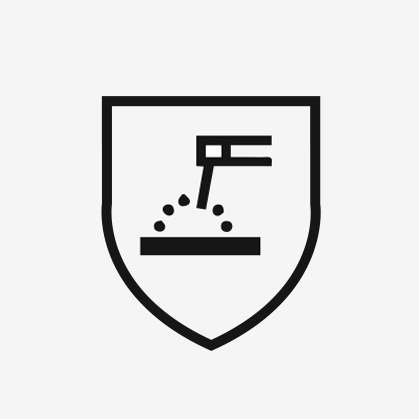
UNI EN ISO 11611:2015 - EUROPEAN STANDARD
Protective clothing used for welding and related processes.
The standard specifies minimum safety requirements and test methods for protective clothing, such as hoods, aprons, sleeves, and gaiters, that are designed to protect the wearer's body, including the head (hoods) and feet (gaiters), they are also intended to be used during welding and related processes, when they pose a considerable risk. The purpose of this type of protective clothing is to protect the user against splashes (small splashes of molten metal), short contact times with flames and radiant heat from an electrical system. They are used for welding or related processes and minimize the possibility of final electric shocks and accidental contact with electrical conductors with voltages up to approximately 100 V DC under normal welding conditions. There are two kinds of protection.
Class 1 refers to protection against less hazardous welding techniques and situations, which produce the lowest levels of spatter and radiant heat. Class 2 refers to protection against the most dangerous welding techniques and situations, which produce the highest levels of spatter and radiant heat.
NOTA (x) = level of protection obtained
A1 or A1+A2, cl. 1 or cl. 2
|
Limited flame spread requirements - ISO 15025 Procedure A (code letter A1) |
|
|
Property |
Requirements |
|
Propagation of the flame |
No sample shall allow any part of the lower limit of a flame or the limit of any hole to reach the upper or vertical edge. |
|
Inflamed residues |
No specimen should generate inflamed residues |
|
Formation of the hole |
No specimen should have holes greater than or equal to 5 mm in any direction, except for an intermediate coating used for specific protection other than heat and flame protection. |
|
Residual glow |
No residual glow> 2s, According to ISO 15025 after the cessation of the flames, the residual incandescence must not spread from the charred area to the intact one. |
|
Residual flame |
The residual flame must be ≤ 2 s. |
|
Limited flame spread requirements - ISO 15025 Procedure B (code letter A2) |
|
|
Property |
Requirements |
|
Propagation of the flame |
No sample shall allow any part of the lower limit of a flame or the limit of any hole to reach the upper or vertical edge. |
|
Inflamed residues |
No specimen should generate inflamed residues |
|
Residual glow |
No residual glow> 2s, According to ISO 15025 after the cessation of the flames, the residual incandescence must not spread from the charred area to the intact one. |
|
Residual flame |
The residual flame must be ≤ 2 s. |
|
Summary of requirements |
||
|
Requirement |
Class 1 |
Class 2 |
|
Tensile strength for external fabrics |
400 N 80 N |
400 N 80 N |
|
Tear resistance for external fabrics |
15 N 15 N |
20 N 20 N |
|
Burst resistance for knitted materials Area to be tested 7.3 cm2 Area to be tested 50 cm2 |
200 kPa 100 kPa |
200 kPa 100 kPa |
|
Seam strength |
225 N |
225 N |
|
Dimensional variation of textile materials For knitted materials |
+/- 3% +/- 5% |
+/- 3% +/- 5% |
|
Propagation of the flame |
ISO 15025 Procedure A & B No hole formation for procedure B |
ISO 15025 Procedure A & B No hole formation for procedure B |
|
Impact of sketches |
15 drops |
25 drops |
|
Heat transfer (radiation) |
RHTI 24 ≥ 7,0 |
RHTI 24 ≥ 16,0 |
|
Electrical resistance |
>105 Ω |
>105 Ω |
|
Harmlessness |
ISO 13688 |
ISO 13688 |

